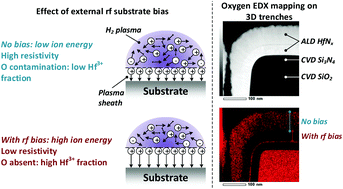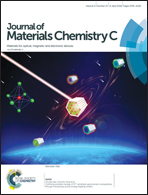Low resistivity HfNx grown by plasma-assisted ALD with external rf substrate biasing†
Abstract
Plasma-assisted atomic layer deposition (ALD) of HfNx thin films using tris(dimethylamino)cyclopentadienylhafnium [CpHf(NMe2)3] as the Hf precursor and H2 plasma as the reducing co-reactant is reported. We previously concluded that the HfNx films prepared for a grounded substrate (0 V substrate potential) exhibited a rather high electrical resistivity of 9.0 × 10−1 Ω cm. In the present work, we show a steady decrease in the electrical resistivity by two orders of magnitude to 3.3 × 10−3 Ω cm upon increasing the time-averaged substrate potential up to −130 V by externally biasing the substrate. A further increase in potential up to −187 V led to an increase in electrical resistivity to 1.0 × 10−2 Ω cm. The variations in electrical resistivity with the potential were found to correlate with the extent of grain boundary scattering in the films, which significantly decreased upon increasing the potential up to −130 V, primarily due to major changes in the film chemical composition. The latter consisted in a decrease in O content from 20.1 at% under no bias to ≤ 2 at% for a potential of −130 V and an associated increase in the Hf3+ fraction from 0.65 to 0.82. The latter is key to the development of low resistivity δ-HfN. A further increase in potential to −187 V led to an increase in grain boundary scattering as a consequence of a major decrease in grain size as well as in-grain crystallinity. In view of advanced nanoelectronic devices, the HfNx layers were also deposited on 3D trench nanostructures at a potential of −130 V. A low oxygen content in the HfNx film was measured on both the planar and vertical topographies of the trenches. Overall, the time-averaged substrate potential has been shown to highly affect the chemical composition, microstructure and the associated electrical properties of the HfNx layers and can be used to tailor the HfNx film properties.

- This article is part of the themed collection: 2018 Journal of Materials Chemistry C HOT Papers


 Please wait while we load your content...
Please wait while we load your content...